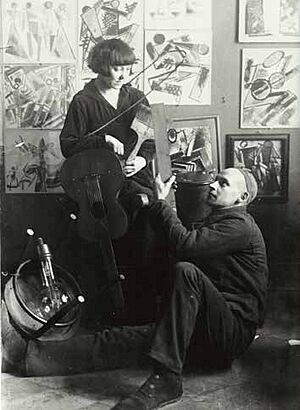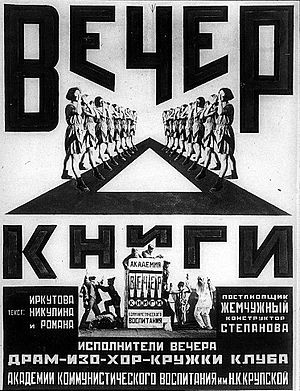Varvara Stepanova facts for kids
Varvara Fyodorovna Stepanova (born November 4, 1894 – died May 20, 1958) was a talented Russian artist. She worked with her husband, Alexander Rodchenko. They were part of the Constructivist art movement in Russia. This group believed art should help build a new society, not just be beautiful. Varvara Stepanova created many things, including propaganda, poems, stage designs, and textile patterns.
Contents
Early Life and Art Journey
Varvara Stepanova was born in Kaunas, which is now in Lithuania. Even though she came from a simple background, she was able to study at the Kazan Art School. There, she met Alexander Rodchenko, who would become her husband and artistic partner.
Before the Russian Revolution of 1917, they lived in Moscow. They became important figures in the Russian avant-garde movement. This art style, starting around 1915, mixed ideas from Cubism, Italian Futurism, and traditional folk art. Stepanova designed art for books and studied painting in Paris.
After the revolution, Stepanova explored many creative fields. She worked on poetry, philosophy, painting, graphic art, stage designs, and clothing. Her work was shown in major art exhibitions in 1919.
Constructivism and New Ideas
Around 1920, artists in Russia had different ideas about art. Some, like Kazimir Malevich, thought art was a spiritual activity. Others believed art should directly help society change. In 1921, Stepanova, Rodchenko, and Aleksei Gan formed the first Working Group of Constructivists.
This group decided to move away from traditional fine art. Instead, they focused on practical things like graphic design, photography, posters, and political messages. In 1921, Stepanova wrote for an exhibition called 5x5=25. She said that art should be an active process, not just something to look at. She believed museums should become archives, not just treasuries of art.
The artists themselves started using the word 'Constructivist' to describe their new direction. Theater was another place where artists could share new social ideas. Stepanova designed the sets for a play called The Death of Tarelkin in 1922.
Designing Clothes and Fabrics
In 1921, Stepanova started focusing on making things that people could use. She felt her designs could help Soviet society the most. Russian Constructivist clothing was meant to be useful and practical. It moved away from fancy, old-fashioned styles. The goal was to create clothing that was functional and geometric, blurring class and gender differences.
Stepanova wanted clothing to free the body, not restrict it. She believed clothes should be seen in action. She designed clothing for specific jobs and activities. Her goal was to make clothes that showed their purpose through their design. She also wanted to find easy ways to make clothes using simple designs and fabric efficiently.
Clothing Styles for Work and Sport
Stepanova divided clothing into two main groups: prodezodezhda (production/working clothes) and sportodezhda (sports clothes). She focused on making these garments in a logical and efficient way. However, it was hard to mass-produce her designs because of poverty after the war. So, most of her designs were not widely made.
The first group, prodezodezhda, included theater costumes and work clothes. In the early 1920s, Stepanova designed costumes for plays. She used geometric shapes to create functional and striking outfits. These costumes were often dark blue and grey. They helped actors move freely and made their movements look more dramatic on stage.
Within this group, she also designed spetsodezhda, which was clothing for specific jobs. She designed clothes for men and women in factories and other professions. She carefully thought about seams, pockets, and buttons to make sure everything was useful. Her work clothes always had a distinct geometric look. They made the body look like a graphic shape, often boxy and gender-neutral.
The second group, sportodezhda, included sports uniforms. These designs also used bold lines, large shapes, and bright colors. This helped athletes move easily and made it simple to tell teams apart. Stepanova even designed team emblems as graphic art. Sports uniforms were often unisex, with pants and a belted tunic.
Creating Fabric Patterns
In 1924, Stepanova became a textile designer at the Tsindel factory near Moscow. She also became a professor of textile design at the Vkhutemas art school. As a Constructivist, she put bold graphic designs on her fabrics. She also cared a lot about how the fabrics were made.
Stepanova worked at the factory for just over a year. During that time, she created more than 150 fabric designs. She wanted to develop new types of fabric, but the technology at the time limited her. She could only print patterns on plain surfaces. She chose to use only one or two colors in her designs. Even though she only used triangles, circles, squares, and lines, she layered them to create dynamic and interesting patterns.
Graphic Design Work
Stepanova was also skilled in typography and book design. She contributed to the magazine LEF in the early 1920s. In 1924, she helped organize a "Book Evening" as part of a government effort to promote reading. This was a performance where characters from old and new books battled each other.
Honoring Her Legacy
On October 22, 2018, Varvara Stepanova was honored with a Google Doodle on what would have been her 124th birthday.
See also
 In Spanish: Varvara Stepánova para niños
In Spanish: Varvara Stepánova para niños




